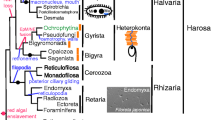Abstract
The relative DNA levels of different developmental stages ofBabesia bigemina andB. canis were measured by cytophotometry using the fluorochrome Hoechst 33258 as a staining dye. The DNA measurements provided direct proof of sexual reproduction, i.e., fusion of gametes resulting in the formation of zygotes followed by a meiotic division. BothBabesia species are considered to be typical members of the genusBabesia; however, the DNA measurements revealed important differences in the life cycle of these parasites, indicating thatBabesia species are not characterized by a life cycle, which is specific for this genus.
Similar content being viewed by others
References
Allsopp MTEP, Cavalier-Smith T, De Waal DT, Allsopp BA (1994) Phylogeny and evolution of the piroplasms. Parasitology 108:147–152
Canning EU, Anwar M (1968) Studies on meiotic division in coccidial and malarial parasites. J Protozool 15:298–308
Canning EU, Morgan K (1975) DNA synthesis, reduction and elimination during life cycles of the eimeriine occidian,Eimeria tenella, and the haemogregarine,Hepatozoon domerguet. Exp Parasitol 38:217–227
Cornelissen AWCA, Overdulve JP, Van der Ploeg M (1984) Determination of nuclear DNA of five eucoccidian parasites,Isospora (Toxoplasma) gondii, Sarcocystis cruzi, Eimeria tenella, E. acervulina andPlasmodium berghei, with special reference to gamontogenesis and meiosis inI. (T.) gondii. Parasitology 88:531–553
Dobell C (1925) The life history and chromosome cycle ofAggregata eberthi (Protozoa: Sporozoa: Coccidia). Parasitology 17:1–136
Gauer M, Mackenstedt U, Mehlhorn H, Schein E, Zapf F, Njenga E, Young A, Morzaria S (1995) DNA measurements and ploidy determination of developmental stages in the life cycles ofTheileria annulata andT. parva. Parasitol Res (in press)
Kakoma I, Mehlhorn H (1994) Babesia of domestic animals. In: Kreier JP (ed) Parasitic protozoa. Academic Press, San Diego, pp 141–216
Kleine FK (1906) Kultivierungsversuch der Hundepiroplasmen. Z Hyg Infektionskr 54:11–16
Koch R (1906) Beiträge zur Entwicklungsgeschichte der Piroplasmen. Z Hyg Infektionskr 54:1–9
Mackenstedt U, Gauer M, Mehlhorn H, Schein E, Hauschild S (1990a) Sexual cycle ofBabesia divergens confirmed by DNA measurements. Parasitol Res 76:199–206
Mackenstedt U, Wagner D, Heydorn AO, Mehlhorn H (1990b) DNA measurements and ploidy determination of different stages in the life cycle ofSarcocystis muris. Parasitol Res 76:662–668
Mackenstedt U, Luton K, Baverstock PR, Johnson AM (1994) Phylogenetic relationships ofBabesia divergens as determined from comparison of small subunit ribosomal RNA gene sequences. Mol Biochem Parasitol 68:161–165
Mehlhorn H, Schein E (1976) Elektronenmikroskopische Untersuchungen an Entwicklungsstadien vonTheileria parva (Theiler, 1904) in Darm der ÜberträgerzeckeHyalomma anatolicum excavatum (Koch, 1844). Trop Med Parasitol 27:182–191
Mehlhorn H, Schein E (1984) The piroplasms: life cycle and sexual stages. Adv Parasitol 23:38–103
Mehlhorn H, Weber G, Schein E, Büscher G (1975) Elektronenmikroskopische Untersuchungen an Entwicklungsstadien vonTheileria annulata (Dschunkowski, Luhs, 1904) im Darm und in der Hämolymphe vonHyalomma anatolicum excavatum (Koch, 1844). Z Parasitenkd 48:137–150
Mehlhorn H, Schein E, Ahmed JS (1994)Theileria. In: Kreier JP (ed) Parasitic protozoa. Academic Press, San Diego, pp 217–304
Moltmann UG, Mehlhorn H, Friedhoff KT (1982a) Ultrastructural study of the development ofBabesia bovis (Piroplasmia) in the vector tickRhipicephalus bursa. J Protozool 29:30–38
Moltmann UG, Mehlhorn H, Friedhoff KT (1982b) Electron microscopic study on the development ofBabesia ovis (Piroplasmia) in the salivary glands of the vector tickRhipicephalus bursa. Acta Trop (Basel) 39:29–40
Raikov IB (1982) The protozoan nucleus. Morphology and evolution. Springer, Wien New York
Ristic M (1988) Babesiosis of domestic animals and man. CRC, Boca Raton
Schein E, Büscher G, Friedhoff KT (1975) Lichtmikroskopische Untersuchungen über die Entwicklung vonTheileria annulata (Dschunkowski and Luhs, 1904) inHyalomma anatolicum excavatum (Koch, 1844). 1. Die Entwicklung im Darm vollgesogener Nymphen. Z Parasitenkd 48:123–136
Scholtyseck E (1963) Vergleichende Untersuchungen über die Kernverhältnisse und das Wachstum bei Coccidiomorphen unter besonderer Berücksichtigung vonEimeria maxima. Z Parasitenkd 22:428–474
Sinden RE, Hartley RH (1985) Identification of the meiotic division of malarial parasites. J Protozool 32:742–744
Young AS, Grootenhuis JG, Leitch BL, Schein E (1980) The development ofTheileria=Cytauxzoon taurotragi (Martin and Brocklesby, 1960) from eland in its tick vectorRhipicephalus appendiculatus. Parasitology 81:129–144
Author information
Authors and Affiliations
Additional information
Supported by Deutsche Forschungsgemeinschaft (DFG)
Rights and permissions
About this article
Cite this article
Mackenstedt, U., Gauer, M., Fuchs, P. et al. DNA measurements reveal differences in the life cycles ofBabesia bigemina andB. canis, two typical members of the genusBabesia . Parasitol Res 81, 595–604 (1995). https://doi.org/10.1007/BF00932027
Received:
Accepted:
Issue Date:
DOI: https://doi.org/10.1007/BF00932027




